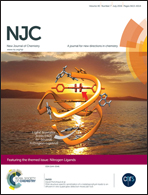Thio-pyridinium capped silver nanoparticle based supramolecular recognition of Cu(i) in real samples and T-lymphocytes
Abstract
The newly synthesized cationic heterocyclic ligand 2 was characterized by NMR and mass spectrometric techniques. It showed great tendency to stabilize readily reducible silver salts and form silver nanoparticles (ThPy-AgNPs). The photophysical properties of these nanoconjugates (ThPy-AgNPs) were studied by AFM, UV-vis absorption and FT-IR spectroscopy. Moreover, the silver nanoparticles (ThPy-AgNPs) decorated with 2 recognizes Cu(I) in the presence of other competing metal ions making it a highly selective and sensitive nanosensor for the recognition of Cu(I) with a limit of detection of 2 μM which is much lower than its threshold level (∼20 μM) in drinking water permitted by the U.S. Environmental Protection Agency (EPA). The nanosensor (ThPy-AgNPs) was screened in pH range of 1–12 and the accuracy was determined by recovery studies. Finally, atomic force microscopy was used to study the interaction of ThPy-AgNPs with Cu(I) in T lymphocytes. The ThPy-AgNPs also selectively recognized Cu(I) in human blood plasma. The utility of this system was also evaluated in real water samples.


 Please wait while we load your content...
Please wait while we load your content...